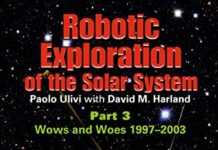
Ebook Info
- Published: 2009
- Number of pages: 550 pages
- Format: PDF
- File Size: 16.97 MB
- Authors: Paolo Ulivi
Description
Provides a comprehensive review in two parts of the exploration of the Solar System, focusing on the technology of the robotic space probes that made it possible, including missions which – for a variety of reasons – were never completed.
User’s Reviews
Reviews from Amazon users which were colected at the time this book was published on the website:
⭐If you’re familiar with the Springer/Praxis series of books on spaceflight history and technology, then “Robotic Exploration of the Solar System: Part 2–Hiatus and Renewal 1983-1996″ needs no introduction. You already know what a superb series it is, with fine production values, well-made volumes designed to stand up to being read repeatedly, authoritative text and liberal use of black-and-white photos, line drawings, charts and tables. You also already know what a great job prolific contributor David M. Harland, and the other series authors, do in bringing space exploration to life.If you’re not familiar with the series or the authors, but are interested in the subject, then this is a great place to dig in. In this thick, heavy tome, Mr. Harland and co-author Paolo Ulivi turn their exceptional narrative skills, technical knowledge and attention to detail to the story of American, Soviet and European unmanned planetary missions during a pivotal time when shock waves from the Space Shuttle Columbia tragedy reverberated through much of the global spaceflight community. Despite the resulting uncertainties, and the need to redesign missions and spacecraft when the Shuttle fleet was grounded and then operationally restricted after it returned to flight status, the period saw many of the most impressive planetary missions to date. The first section of about 140 pages (labeled as Chapter 4 because it continues from ”
⭐”) covers in great detail the many international missions to Halley’s Comet, taking advantage of an observational and scientific opportunity that occurs only once every 76 years. Chapter 5 (the second section of nearly 200 pages) looks at the vehicles, operations and discoveries of the Magellan, Galileo, Ulysses and (failed) Mars Observer missions. The final 120-page section (Chapter 6) focuses on the designs and results of missions under NASA’s “faster, better, cheaper” approach, as exemplified by Mars Pathfinder and Mars Global Surveyor.As usual in the series, the presentation of the material is outstanding. Despite what some might consider “dry” subject matter (“the lander weighed so many kilograms and carried so many kilograms of fuel for its x-Newton thrust rocket engine”), I never found this volume to be at all boring. About 250 illustrations perfectly complement the text, many of them photographs from the imaging instruments aboard the spacecraft and all of them clearly and usefully captioned.If you want to know something about unmanned planetary exploration, this is the book for you. While it is the second volume in a series of three, you can easily read it as a stand-alone history. But why would you? Pick up the first and third volumes as well, and you’ll be very well-versed in the subject for a modest outlay. Kudos to the authors and to Springer/Praxis for raising the story of spaceflight to a new level of excellence.
⭐By far this is the best book series I have read on planetary science. It gives you a description of the spacecraft and the mission and the outputs of said mission. My quips have more to do with things that the authors were not able to know at the time of publication (2009), such as that Ulysses was not contacted in 2013 or that Russia did try to launch another planetary mission after Mars 96, Phobos Grunt. It has the nest description I have seen for Galileo or Magellan
⭐Fantastic book. Excellent information. The robotic exploration of the solar system is one of the most interesting topic in modern science and technology because it involves politics, science, risk and exploration of new worlds, plus many amazing discoveries. It is absolutely fascinating and emotive. I have read many books about unmanned science exploration and this –and also part one– is very well written and structured.
⭐Excellent explanation of robotics use in recent space exploration missions. Includes considerations of how the robot will function in the environment it will be going to as well as how they actually performed upon arrival at the destination. The book includes technical information but can be understood by the reader.
⭐Robotic Exploration of the Solar System Part 2 Hiatus and Renewal 1983-1989 is the second book in this comprehensive series describing planetary (and interplanetary) space missions. It’s a hefty 535 pages packed with information. A glance at the long list of references will quell any doubts about whether the authors did their homework.Where the first book in the series covered dozens and dozens of missions in the so called Golden Age this book describes only 19. The decline was due to the priorities given to the Shuttle and Space Station in the US while the USSR was in a terminal decline. Partially filling in the void were the emergence of the ESA and Japan in the planetary field.The book describes all the missions in great detail from earliest proposals to last signal. The Galileo mission in particular is an orbit by orbit, encounter by encounter description lasting over a hundred pages. Not only are the flown missions described but the greater context of proposals and cancelled missions are provided.This is not a book for the space tyro; there is very little in the way of explanations of scientific and technical matters. The wide variety of the instruments these probes carried and experiments performed will include some that even the most dedicated and long standing will not fully understand.The illustrations complement the text very well. The only complaint is that there are no color illustrations in the book and the originals of some graphs and charts required color to fully understand them.While not strictly necessary, I would strongly urge reading Part 1 before reading this book. While the authors seem to have picked as good a division as possible there is a certain loss of continuity if Part 1 is not read first.All in all an outstanding book; I can’t wait for Part 3.
⭐Paolo Ulivi’s ” Robotic Exploration of the Solar System – Part 2 – Hiatus and renewal 1983-1996 ” is a must have for unmanned spaceflight aficionados! Co-written by David Harland, the book had the usual Springer quality and look & feel. Excellent summary of the unmanned spaceflight missions of the last 2 decades of the 20th century. Both actual and cancelled missions are discussed on 535 pages covering Venus Orbiting Imaging Radar, Giotto, Vega, Magellan, Galileo, Ulysses, NEAR, Mars 94/96, Sojourner… to name a few missions!Already looking forward to part 3 of these series!Philip Corneille
⭐Loads of technical informations but page layout is dull.
Keywords
Free Download Robotic Exploration of the Solar System: Part 2: Hiatus and Renewal, 1983-1996 (Springer Praxis Books) 2009th Edition in PDF format
Robotic Exploration of the Solar System: Part 2: Hiatus and Renewal, 1983-1996 (Springer Praxis Books) 2009th Edition PDF Free Download
Download Robotic Exploration of the Solar System: Part 2: Hiatus and Renewal, 1983-1996 (Springer Praxis Books) 2009th Edition 2009 PDF Free
Robotic Exploration of the Solar System: Part 2: Hiatus and Renewal, 1983-1996 (Springer Praxis Books) 2009th Edition 2009 PDF Free Download
Download Robotic Exploration of the Solar System: Part 2: Hiatus and Renewal, 1983-1996 (Springer Praxis Books) 2009th Edition PDF
Free Download Ebook Robotic Exploration of the Solar System: Part 2: Hiatus and Renewal, 1983-1996 (Springer Praxis Books) 2009th Edition


